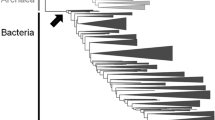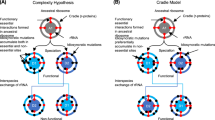Abstract
Previous studies have reported a positive correlation between the GC content of the double-stranded regions of structural RNAs and the optimal growth temperature (OGT) in prokaryotes. These observations led to the hypothesis that natural selection favors an increase in GC content to ensure the correct folding and the structural stability of the molecule at high temperature. To date these studies have focused mainly on ribosomal and transfer RNAs. Therefore, we addressed the question of the relationship between GC content and OGT in a different and universally conserved structural RNA, the RNA component of the signal recognition particle (SRP). To this end we generated the secondary structures of SRP-RNAs for mesophilic, thermophilic, and hyperthermophilic bacterial and archaeal species. The analysis of the GC content in the stems and loops of the SRP-RNA of these organisms failed to detect a relationship between the GC contents in the stems of this structural RNA and the growth temperature of bacteria. By contrast, we found that in archaea the GC content in the stem regions of SRP-RNA is highest in hyperthermophiles, intermediate in thermophiles, and lower in mesophiles. In these organisms, we demonstrated a clear positive correlation between the GC content of the stem regions of their SRP-RNAs and their OGT. This correlation was confirmed by a phylogenetic nonindependence analysis. Thus we conclude that in archaea the increase in GC content in the stem regions of SRP-RNA is an adaptation response to environmental temperature.





Similar content being viewed by others
References
Batey RT, Rambo RP, Lucast L, Rha B, Doudna JA (2000) Crystal structure of the ribonucleoprotein core of the signal recognition particle. Science 287:1232–1239
Bernstein HD, Zopf D, Freymann DM, Walter P (1993) Functional substitution of the signal recognition particle 54-kDa subunit by its Escherichia coli homolog. Proc Natl Acad Sci USA 90:5229–5233
Bhuiyan SH, Gowda K, Hotokezaka H, Zwieb C (2000) Assembly of archaeal signal recognition particle from recombinant components. Nucleic Acids Res 28:1365–1373
Bradshaw N, Neher SB, Booth DS, Walter P (2009) Signal sequences activate the catalytic switch of SRP RNA. Science 323:127–130
Brochier-Armanet C, Boussau B, Gribaldo S, Forterre P (2008) Mesophilic Crenarchaeota: proposal for a third archaeal phylum, the Thaumarchaeota. Nat Rev Microbiol 6:245–252
Connolly T, Rapiejko PJ, Gilmore R (1991) Requirement of GTP hydrolysis for dissociation of the signal recognition particle from its receptor. Science 252:1171–1173
Corder GW, Foreman DI (2009) Nonparametric statistics for non-statisticians: a step-by-step approach. Wiley, New York
Diener JL, Wilson C (2000) Role of SRP19 in assembly of the Archaeoglobus fulgidus signal recognition particle. Biochemistry 39:12862–12874
Egea PF, Shan SO, Napetschnig J, Savage DF, Walter P, Stroud RM (2004) Substrate twinning activates the signal recognition particle and its receptor. Nature 427:215–221
Egea PF, Napetschnig J, Walter P, Stroud RM (2008) Structures of SRP54 and SRP19, the two proteins that organize the ribonucleic core of the signal recognition particle from Pyrococcus furiosus. PLoS One 3:e3528
Eichler J, Moll R (2001) The signal recognition particle of Archaea. Trends Microbiol 9:130–136
Felsenstein J (1985) Phylogenies and the comparative method. Am Nat 125:1–15
Galtier N, Lobry JR (1997) Relationships between genomic G+C content, RNA secondary structures, and optimal growth temperature in prokaryotes. J Mol Evol 44:632–636
Gilmore R, Walter P, Blobel G (1982) Protein translocation across the endoplasmic reticulum. II. Isolation and characterization of the signal recognition particle receptor. J Cell Biol 95:470–477
Gruber AR, Lorenz R, Bernhart SH, Neubock R, Hofacker IL (2008) The Vienna RNA websuite. Nucleic Acids Res 36:W70–W74
Hainzl T, Huang S, Sauer-Eriksson AE (2002) Structure of the SRP19 RNA complex and implications for signal recognition particle assembly. Nature 417:767–771
Hainzl T, Huang S, Sauer-Eriksson AE (2005) Structural insights into SRP RNA: an induced fit mechanism for SRP assembly. RNA 11:1043–1050
Halic M, Becker T, Pool MR, Spahn CM, Grassucci RA, Frank J, Beckmann R (2004) Structure of the signal recognition particle interacting with the elongation-arrested ribosome. Nature 427:808–814
Huang SL, Wu LC, Liang HK, Pan KT, Horng JT, Ko MT (2004) PGTdb: a database providing growth temperatures of prokaryotes. Bioinformatics 20:276–278
Huck L, Scherrer A, Terzi L, Johnson AE, Bernstein HD, Cusack S, Weichenrieder O, Strub K (2004) Conserved tertiary base pairing ensures proper RNA folding and efficient assembly of the signal recognition particle Alu domain. Nucleic Acids Res 32:4915–4924
Keenan RJ, Freymann DM, Stroud RM, Walter P (2001) The signal recognition particle. Annu Rev Biochem 70:755–775
Larsen N, Zwieb C (1991) SRP-RNA sequence alignment and secondary structure. Nucleic Acids Res 19:209–215
Maddison WP, Maddison DR (2009) Mesquite: a modular system for evolutionary analysis. Version 2.6. Available at: http://mesquiteproject.org
Maeshima H, Okuno E, Aimi T, Morinaga T, Itoh T (2001) An archaeal protein homologous to mammalian SRP54 and bacterial Ffh recognizes a highly conserved region of SRP RNA. FEBS Lett 507:336–340
Markowitz VM, Szeto E, Palaniappan K, Grechkin Y, Chu K, Chen IM, Dubchak I, Anderson I, Lykidis A, Mavromatis K, Ivanova NN, Kyrpides NC (2008) The integrated microbial genomes (IMG) system in 2007: data content and analysis tool extensions. Nucleic Acids Res 36:D528–D533
Midford PE, Garland T, Maddison WP (2005) PDAP package of mesquite. Version 1.07. Available at: http://mesquiteproject.org
Nakashima H, Fukuchi S, Nishikawa K (2003) Compositional changes in RNA, DNA and proteins for bacterial adaptation to higher and lower temperatures. J Biochem 133:507–513
Rosenblad MA, Gorodkin J, Knudsen B, Zwieb C, Samuelsson T (2003) SRPDB: Signal Recognition Particle Database. Nucleic Acids Res 31:363–364
Sauer-Eriksson AE, Hainzl T (2003) S-domain assembly of the signal recognition particle. Curr Opin Struct Biol 13:64–70
Schmitz U, Behrens S, Freymann DM, Keenan RJ, Lukavsky P, Walter P, James TL (1999) Structure of the phylogenetically most conserved domain of SRP RNA. RNA 5:1419–1429
Schroeder R, Barta A, Semrad K (2004) Strategies for RNA folding and assembly. Nat Rev Mol Cell Biol 5:908–919
Shigi N, Suzuki T, Terada T, Shirouzu M, Yokoyama S, Watanabe K (2006) Temperature-dependent biosynthesis of 2-thioribothymidine of Thermus thermophilus tRNA. J Biol Chem 281:2104–2113
Siegel V, Walter P (1988) Binding sites of the 19-kDa and 68/72-kDa signal recognition particle (SRP) proteins on SRP RNA as determined in protein-RNA “footprinting”. Proc Natl Acad Sci USA 85:1801–1805
Spearman C (1904) The proof and measurement of association between two things. Am J Psychol 15:72–101
Tozik I, Huang Q, Zwieb C, Eichler J (2002) Reconstitution of the signal recognition particle of the halophilic archaeon Haloferax volcanii. Nucleic Acids Res 30:4166–4175
Varriale A, Torelli G, Bernardi G (2008) Compositional properties and thermal adaptation of 18S rRNA in vertebrates. RNA 14:1492–1500
Walter P, Blobel G (1981) Translocation of proteins across the endoplasmic reticulum III. Signal recognition protein (SRP) causes signal sequence-dependent and site-specific arrest of chain elongation that is released by microsomal membranes. J Cell Biol 91:557–561
Wang HC, Hickey DA (2002) Evidence for strong selective constraint acting on the nucleotide composition of 16S ribosomal RNA genes. Nucleic Acids Res 30:2501–2507
Wang HC, Xia X, Hickey D (2006) Thermal adaptation of the small subunit ribosomal RNA gene: a comparative study. J Mol Evol 63:120–126
Wolin SL, Wurtmann EJ (2006) Molecular chaperones and quality control in noncoding RNA biogenesis. Cold Spring Harb Symp Quant Biol 71:505–511
Yin J, Huang Q, Pakhomova ON, Hinck AP, Zwieb C (2004) The conserved adenosine in helix 6 of Archaeoglobus fulgidus signal recognition particle RNA initiates SRP assembly. Archaea 1:269–275
Yurist S, Dahan I, Eichler J (2007) SRP19 is a dispensable component of the signal recognition particle in Archaea. J Bacteriol 189:276–279
Zuker M (2003) Mfold web server for nucleic acid folding and hybridization prediction. Nucleic Acids Res 31:3406–3415
Zwieb C (1991) Interaction of protein SRP19 with signal recognition particle RNA lacking individual RNA-helices. Nucleic Acids Res 19:2955–2960
Zwieb C (1992) Recognition of a tetranucleotide loop of signal recognition particle RNA by protein SRP19. J Biol Chem 267:15650–15656
Zwieb C (1994) Site-directed mutagenesis of signal-recognition particle RNA. Identification of the nucleotides in helix 8 required for interaction with protein SRP19. Eur J Biochem 222:885–890
Zwieb C, Eichler J (2002) Getting on target: the archaeal signal recognition particle. Archaea 1:27–34
Zwieb C, Muller F, Larsen N (1996) Comparative analysis of tertiary structure elements in signal recognition particle RNA. Fold Des 1:315–324
Zwieb C, van Nues RW, Rosenblad MA, Brown JD, Samuelsson T (2005) A nomenclature for all signal recognition particle RNAs. RNA 11:7–13
Acknowledgments
We thank Drs. F. Langa, and J. Y. Zhang for their critical reading of the manuscript and suggestions. We are also grateful to Jean-Christophe Aude for helping with the statistical analysis. Dr. C. Brochier is gratefully acknowledged for providing the phylogenetic tree of the archaea based on concatenated ribosomal proteins. We thank the two anonymous referees for their helpful comments.
Author information
Authors and Affiliations
Corresponding author
Electronic supplementary material
Below is the link to the electronic supplementary material.
Rights and permissions
About this article
Cite this article
Miralles, F. Compositional Properties and Thermal Adaptation of SRP-RNA in Bacteria and Archaea. J Mol Evol 70, 181–189 (2010). https://doi.org/10.1007/s00239-009-9319-1
Received:
Accepted:
Published:
Issue Date:
DOI: https://doi.org/10.1007/s00239-009-9319-1




